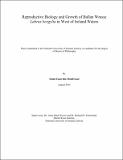| dc.contributor.advisor | Power, Anne Marie | |
| dc.contributor.advisor | Fitzgerald, Richard | |
| dc.contributor.author | Mohd Yusof, Mohd Faizzi | |
| dc.date.accessioned | 2015-11-25T09:59:57Z | |
| dc.date.issued | 2015-08-15 | |
| dc.identifier.uri | http://hdl.handle.net/10379/5350 | |
| dc.description.abstract | The research undertaken is very relevant to the aquaculture industry and fisheries management as it addresses natural cycle of the reproductive parameters including sex hormones, gonads development and nutritional background. Highest concentrations of circulatory estradiol and testosterone in the plasma coincided with the preponderance of vitellogenic follicles in the ovary and also had a sharply increased GSI. Manipulation of reproduction by induced breeding was successfully undertaken from captive and wild Labrus bergylta. Using hormonal agonist injections clearly demonstrated that hCG can advance, synchronize ovulation and spawning in L. bergylta without affecting egg quality. Egg and larval growth from artificial spawning from two different batches of L. bergylta broodstock were compared on the weaning onto formulated feed of two different diets to describe growth. Growth was positive followed an exponential curve between batches and diets of larvae, with varying changes in growth rates at different points in the development from hatching to 112 dph. In spawning batch II, larvae fed Diet B (micropellet + polychaetes) gave significant growth comparable to Diet A (micropellet alone) in term of dry weight and wet weight for the period when diets actually differed (49-112 dph). Mean standard lengths or myotome heights of larvae showed no effect of diet but significant effects according to spawning batch. This underlines the fact that spawning batch had a greater effect than diet, while mean specific growth rates (SGRs) declined over time with growth slowing down as larvae got older on all growth measures. Micro and macro- incremental counts of the sagittal otoliths from laboratory reared larvae and monthly sampled juveniles and adults were undertaken as a means to validate the number of rings deposited daily and yearly for ageing L. bergylta. Most relationships between the growth variables for L. bergylta were best described by regression with a quadratic fit or curvilinear relationship. The modelled maximum length from von Bertalanffy growth function (VBGF) in the present study gave L = 42.48±0.884 cm and growth rates (k) of 0.16±0.013 year-1 for all L. bergylta (male plus female). The relationship between fish length with otolith length, otolith weight and age (in years) for L. bergylta indicated strong positive correlations. Overall, the results suggest that fish length was a good predictor of age. | en_IE |
| dc.rights | Attribution-NonCommercial-NoDerivs 3.0 Ireland | |
| dc.rights.uri | https://creativecommons.org/licenses/by-nc-nd/3.0/ie/ | |
| dc.subject | Ballan wrasse | en_IE |
| dc.subject | Zoology | en_IE |
| dc.subject | Natural sciences | en_IE |
| dc.subject | Biology | en_IE |
| dc.subject | Reproductive biology | en_IE |
| dc.subject | Ireland | en_IE |
| dc.subject | Martin Ryan Institute | en_IE |
| dc.title | Reproductive biology and growth of Ballan Wrasse Labrus Bergylta in west of Ireland waters | en_IE |
| dc.type | Thesis | en_IE |
| dc.contributor.funder | Malaysian Government | en_IE |
| dc.local.note | The study indicates the biology of ballan wrasse in the west coast of Ireland waters. A 16 months reproductive parameters and artificial spawning gave an important baseline information of this species. Growth and ageing from larvae to adults ballan wrasse were also been studied in extend. | en_IE |
| dc.description.embargo | 2019-11-18 | |
| dc.local.final | Yes | en_IE |
| nui.item.downloads | 84 | |


